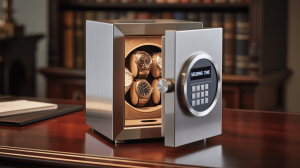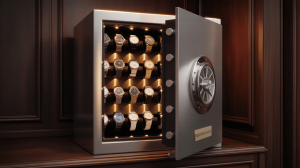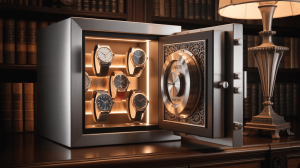Expert Tips for Organizing Your Watches in a Display Safe. But here’s the kicker… Even the finest collection can fall into chaos without a plan. Follow these 15 expert strategies to arrange, protect, and showcase each timepiece like a pro.
1. Inventory and Categorize by Style
Here’s the deal… Start by listing every watch—dress, sport, dive, or vintage. Group by size, function, and frequency of wear. This clarity prevents overcrowding and ensures quick selection.
| Category | Characteristics | Example |
|---|---|---|
| Dress | Slim cases, leather straps | Classic chronograph |
| Sport | Larger cases, rubber or metal | Diver’s watch |
2. Measure Pillow and Slot Dimensions
Accurate sizing avoids jostling. Measure each pillow’s height and width plus strap thickness. Leave ¼-inch clearance on all sides for easy removal without friction.
3. Arrange by Frequency of Use
Place everyday wearers front and center. Less-used or sentimental pieces go deeper or higher. This prioritization streamlines daily routines and keeps prized watches safe but accessible.
4. Utilize Adjustable Foam Inserts
Here’s the deal… Foam inserts with cuttable cubes let you tailor cavities per watch diameter. Cut only what you need, keeping adjacent sections intact for future additions.
| Insert Type | Foam Density | Best Use |
|---|---|---|
| Soft Foam | Low | Delicate vintage watches |
| Medium Foam | Medium | General collection |
| High-Density | High | Heavy or oversized watches |
5. Implement Color-Coded Zones
Use colored liners or labels to identify categories at a glance—black for dress, blue for dive, red for tourbillon. This visual cue reduces search time and enhances display aesthetics.
6. Store Straps and Accessories Separately
Dedicated compartments for extra straps, spring bars, and winding tools keep clutter away from watch pillows. Small zip pockets under trays preserve tools and papers without swallowing display space.
7. Incorporate Watch Winders Strategically
Here’s the deal… Automatic watches need motion. Assign winding modules only to active pieces. Static storage for seldom-worn automatics prevents unnecessary wear on winding mechanisms.
| Module Type | TPD Range | Recommended For |
|---|---|---|
| Single Winder | 650–1,000 | One high-use automatic |
| Multi-Winder | 1,000–2,000 | Multiple daily rotations |
8. Optimize Lighting for Visibility
LED strips or edge-lit panels highlight details without heat. Position lights to avoid glare on crystal surfaces. Dimmer switches let you adjust mood and focus.
9. Maintain Proper Humidity Levels
Leather straps and metal movements thrive at 40–50% RH. Use desiccant packs in sealed chambers and check digital hygrometers monthly. Rotate or replace packs every 6–12 months.
10. Implement a Rotation Schedule
Here’s the deal… Even quartz watches benefit from occasional movement to prevent gasket drying. Create a calendar—manual reminders for weekly or monthly repositioning—and stick to it.
| Frequency | Action | Benefit |
|---|---|---|
| Daily | Rotate primary automatics | Keeps lubricants fluid |
| Weekly | Move static watches slightly | Prevents seal sticking |
| Monthly | Clean pillows and slots | Removes dust and debris |
11. Clean and Condition Interior Linings
Velvet or suede linings attract dust. Use a soft brush or lint roller every quarter. For leather trims, apply a gentle conditioner to prevent cracking and maintain color.
12. Secure Quick-Access Favorites
Install a small front compartment for one or two go-to watches. A slim drawer or side panel with a simple latch offers rapid retrieval without opening the entire safe.
13. Label Compartments Discreetly
Here’s the deal… Tiny engraved plaques or color dots at each slot help you recall placement—especially handy for rotating pieces. Keep labeling subtle to preserve elegance.
| Label Style | Material | Visibility |
|---|---|---|
| Metal Plaque | Brass or stainless | High contrast on dark lining |
| Color Dot | Resin sticker | Easy change when needed |
14. Monitor Security and Environment
Use smart sensors for tamper alerts, temperature, and humidity notifications via smartphone. Instant alerts let you address issues—like rising humidity—before damage occurs.
15. Review and Refresh Quarterly
Every three months, reassess your arrangement. Move pieces for even light exposure, replace aging inserts, and verify lock and lighting functions. This routine keeps your display safe looking and functioning like new.
Conclusion
Organizing your watches in a display safe combines precision, planning, and care. Ready for the good part? Apply these expert tips to transform chaos into curated elegance—and protect your collection with confidence.
FAQ
Q1: How much clearance should each watch have?
About ¼-inch on all sides to prevent contact and scratching.
Q2: Can I mix quartz and automatic watches in the same safe?
Yes—just assign winding modules to automatics and static slots to quartz.
Q3: How often replace foam inserts?
Every 2–3 years or when they show compression.
Q4: Are smart sensors necessary?
Optional but highly recommended for environmental monitoring.
Q5: What’s the best way to clean velvet linings?
Use a soft brush or lint roller; avoid moisture to prevent matting.







